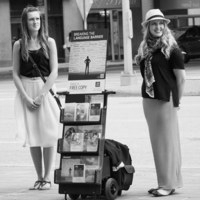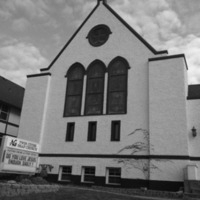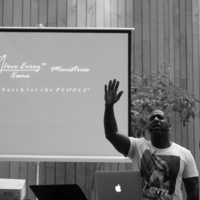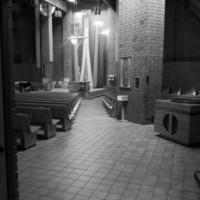Christian
Nile Our Savior Lutheran Church

Quietly situated among the cornfields and farmlands of southeastern Minnesota lies the city of Faribault, a town of relative ethnic...
Living Word Christian Center

View of LWCC from the parking lot, photo courtesy of LWCC Founded in 1980 with an original membership of 12, Living...
Bethlehem Baptist Church

Located just blocks away from US Bank Stadium in Minneapolis, the Downtown Campus of Bethlehem Baptist Church is the oldest...
Assisi Heights

Rochester, a city of 200,000 people in the southeast corner of Minnesota, is the home of the Mayo Clinic, an...
First Universalist Church of Minneapolis

An ethnographic study of perspectives of leaders and congregants at the First Universalist Church of Minneapolis.
History of Faribault

An exhibit on the history of the town of Faribault, from the 19th century until today.
Christianity is the largest religion in the world, as well as in the United States and Minnesota, with many different branches and denominations grounded in the life, death, resurrection, and teachings of Jesus Christ, who lived as a Jew under Roman occupation and taught his followers to lead lives of love, service, and justice before his crucifixion at age thirty-three. In the centuries after his death, Christianity spread around the Mediterranean and far into Asia and Europe. The Bible is Christianity's central text and includes both the Old and New Testaments, with the former providing background for four canonical gospels of Matthew, Mark, Luke, and John in the latter. Disagreements in Christianity about a wide array of theological, ecclesiological, ideological debates have led to schisms and the creation of many different churches and denominations, roughly divisible into Western (Roman Catholicism and Protestantism) and Eastern (Orthodox churches) branches. Christianity was instrumental in the formation of European society and Western civilization, spreading to the Americas and the rest of the world during the Age of Exploration and after. For more information, please visit the Pluralism Project's pages on Christianity.
The history of Christianity in Minnesota begins with Monsieur de Saint Lusson and the Jesuit priest Claude Allouez, who raised a cross on an overlook at Sault Ste. Marie, deep in Ojibwe territory where Lake Superior meets Lake Huron. Thus, on June 4th, 1671, they claimed the region for the Christian kingdom of New France; this practice of claiming land occupied by indigenous peoples for Christianity became legal doctrine in the United States in 1823. Galvanized by the currents of the Second Great Awakening, Protestant missions that focused on converting Dakota and Ojibwe peoples gathered steam in Minnesota in the 1830s. While some indigenous people converted fully, many Dakota and Ojibwe blended Christian practices with the more traditional practices of their respective spiritualities, reflecting the resistance to complete assimilation that indigenous Minnesotans have exhibited for centuries.
European immigration to Minnesota boomed in the 19th century, and large numbers of Germans, Norwegians, Swedes, and Irish spread throughout the state, greatly increasing the Protestant and Catholic population. Some immigration was sponsored by Minnesota religious figures but most was not; either way, it led to the establishment of churches, monasteries, and colleges where religious life carried on in immigrants' native languages. Catholic divisions between earlier German and Irish immigrants were, in some ways, mirrored by the preponderance of different Protestant churches that emerged with mass immigration in the late 19th century and dampened the Protestant majority's influence. The predominance of Catholics and Protestants in Minnesota that began in the 19th century and continues into the 21st provoked anti-Catholicism and the fear of Romanism, or the alleged threats posed by the papacy to all areas of American life. Catholicism was seen as incompatible with American democracy and religious freedom, consistent with anti-Islamic arguments made today. John Ireland, who bolstered Minnesota's influence in American religious history as archbishop of St. Paul from 1888 to 1918, resisted such logic and helped fuse Minnesota's Catholic immigrant groups into a distinctly American Catholicism.
Many Minnesota Christians became more accepting of different religions as they reckoned with the advent of modernity in the 19th and 20th centuries. African American Christians in Minnesota formed African Methodist Episcopal (AME), Baptist, and Pentecostal churches, such as St. James AME Church in Minneapolis in 1863. This burgeoning but imperfect inclusion was exemplified by the World's Parliament of Religions, part of the Columbian Exposition in Chicago in 1893, which increased American exposure to other religions and encouraged further dialogue. In response to growing religious liberalism, conservative Protestants in Minnesota, led by the Baptist fundamentalist William Bell Riley in the late-19th century, entrenched themselves in the Bible's authoritative inerrancy and opposed dancing, playing cards, theater, and the teaching of Darwinian evolution in public schools. Riley's chosen successor in 1947 was a young North Carolinian named Billy Graham, a vital figure in the growing evangelical movement of the 20th century, reminiscent of the Protestant missions of the 1830s. Both the religious left and right became increasingly politically active in the 1960s as debates emerged about gender roles, gay and lesbian rights, and abortion, a move towards political mobilization that has continued into the present.
Immigration of Christians from Eastern Europe increased in the early 20th century but was halted abruptly by the Immigration Act of 1924. The Immigration and Nationality Act of 1965 removed the strict quotas of 1924 and unleashed waves of change in Minnesota. While the state is still overwhelmingly Protestant and Catholic, it has also become home to large immigrant and refugee populations that shape American Christianity in new ways with their diverse traditions and expressions of faith.
There are more than 280,000 Latinxs in Minnesota, primarily of Mexican descent but also from Puerto Rico, El Salvador, Guatemala, Ecuador, Cuba, and Colombia. These communities are complex and diverse and defy simple labels or types. They're largely Catholic and often incorporate indigenous traditions into their Catholic practices. Churches and home altars are centers of daily religious life for many Latinxs. The Virgin Mary, Our Lady of Guadalupe, is regarded as the Patroness of the Americas and is an important devotional figure, especially for Mexican Catholics. Mexicans first arrived in Minnesota as migrant workers on sugar beet farms in the early 20th century but few stayed permanently. While some settled in the Twin Cities in the 1920s and onward, after 1990, the Mexican population in Minnesota exploded as people came for economic opportunity and established churches, stores, and other organizations that fostered community and familiarity. Also in the 1990s and 2000s, economic and political factors pushed people out of Latin American countries and to states like Minnesota. Throughout their history in the state, Minnesota Latinxs have faced discrimination, forced deportations, and difficulties in being recognized as Americans, even though the majority were born in the U.S. Regardless, Latinx immigrants have brought their vibrant cultures, languages, and unique religious traditions to the Land of 10,000 Lakes.
About 25,000 Filipinos live in Minnesota, with over 70% residing in the Twin Cities. Most Filipinos are Catholic because of the colonial relationship between Spain and the Philippines. Generally, Filipinos in Minnesota speak English well and are highly educated and well-off economically. When the U.S. received the Philippines from Spain after the Spanish-American War at the end of the 19th century, it established English schools and a scholarship system for Filipino males to study in the U.S. These students were called pensionados, and along with migrant laborers were some of the first Filipinos to live in the U.S. Few Filipinos chose Minnesota as a destination and most went home after their studies. Immigration exploded after 1965 as families arrived and grew. Several cultural and religious organizations support Filipinos in Minnesota, including the Filipino American Christian Church in Mounds View and the Fil-Minnesotan Association, created in 1953. While it is relatively easy for Filipinos to assimilate to American culture, this makes cultural preservation even more important, and Filipinos also deal with health issues, racial discrimination, and historical trauma from long colonial conflicts and legacies, Japanese occupation during World War II, and the harsh reign of Ferdinand Marcos in the 1970s and '80s.
Another group of Minnesota Christians is the Karen, an ethnic group from Myanmar, which boasts a population of around 15,000 in Minnesota, the largest anywhere in the U.S. They are concentrated in the Twin Cities and have generally arrived in the U.S. very recently. The Karen people have tried to create an independent state in the Kayin State of Myanmar since 1949, resulting in repeated conflicts with Myanmar that constitute the world's longest continuing civil war. The conflict and persecution have displaced hundreds of thousands of Karen, who have fled to refugee camps in neighboring Thailand. Language barriers present difficulties for Karen refugees in Minnesota, and poverty and low educational achievement are also problems. The Karen Organization of Minnesota seeks to improve opportunities for education and employment and increase access to social and health services. While most Karen in Asia are Buddhist, Christianity is the largest religion among Minnesota Karen. Churches have also been important places for community connection, and the First Baptist Church in St. Paul is predominantly Karen, holding services in English and their native language.
Minnesota is also home to about 45,000 Ethiopians and Kenyans belonging to the Oromo ethnic group, concentrated in the Twin Cities, which is known as Little Oromia and boasts the largest Oromo population outside Africa. Many were driven out of East Africa by escalating tensions with Ethiopia in the 1970s, which hearken back to the late 19th century, when European powers affirmed Abyssinia's (modern Ethiopia) Christian influence by arming the empire, allowing the Abyssinians to crack down on the Oromos, their historical enemy. The first Oromos to arrive in Minnesota in the 1970s were students and were able to escape danger in Ethiopia—worsened by a military coup in 1974 and the deposition of the long-ruling emperor—through contacts at Lutheran missionaries tied to Minnesota. These Christian organizations and the Oromo Relief Association of North America, founded by some of the first refugees, proved vital as the situation worsened in the 1980s and East African refugee camps overflowed. Further political chaos fueled another wave in the 1990s, which saw the number of African immigrants to Minnesota increase by 600 percent. In 1987, Christian Oromos began gathering in Minneapolis for Bible study and prayer, forming Our Redeemer Oromo Evangelical Church in 1993. Many Oromos embarked on cultural education missions to spread awareness of Ethiopian history and the Oromos' plight, especially through visiting churches and gaining support from religious organizations.
Unpublished Exhibits
Apple Valley Congregation of Jehovah's Witnesses

An exhibit about a group of Jehovah's Witnesses in Minnesota.
Brazilian Christianity in Greater Minneapolis

THIS SITE “Brazilian Christianity in Greater Minneapolis” is currently under construction and undergoing editing.
Religion and First Amendment Law

Information and fieldwork related to the Free Exercise Clause and Establishment Clause Kayla Jackson, Sara Klugman, Will Yetvin, assist.
Deaf Life Church

St. Joan of Arc Catholic Community

Saint Joan of Arc Catholic Community is a Roman Catholic church that sits close to the intersection of 46th street and...
Centro Cristiano Nueva Esperanza

Centro Cristiano Nueva Esperanza, or New Hope Christian Center in English, is a new and growing church in the West...
Simplicity of Religious Space in Mennonite and Quaker Meetings

How is religious space created? Across time and cultures, there have been endless variations on the theme of sacred space....
Immigration and Religion in MN: A Retrospective of Bethel Christian Fellowship

Japanese Fellowship Church

The Japanese Fellowship Church (JFC) is a Protestant church located in the quiet neighborhood of Bancroft, Hennepin County in southern...
Minneapolis Friends Meeting

The Minneapolis Friends Meeting, located near Lake Harriet in Southwest Minneapolis is home to about 275 members and attendees. Included...
First United Church of Christ, Northfield

Spring 2016 project on First United Church of Christ in Northfield, MN. Created by August Leinbach '17
Grace Church

Despite Grace Church’s large size and clean look, its simple architecture and humble cross protruding into the flat landscape don’t...
Building Community in Central Minnesota

This site explores the issues regarding Islamophobia and discrimination against Somali Muslims in St. Cloud, Minnesota and efforts by local...
Above Every Name Ministries

Above Every Name Ministries is church for the people. Founded by Pastor Danny Givens in 2011, Above Every Name is...
First Hmong Assembly of God Church

Billy Graham Evangelistic Association

Listen to Minnesota Religions





